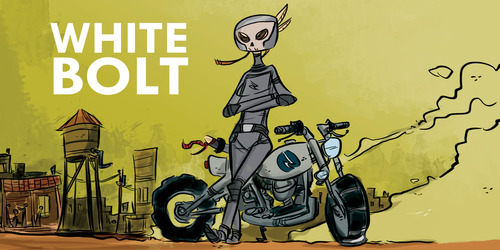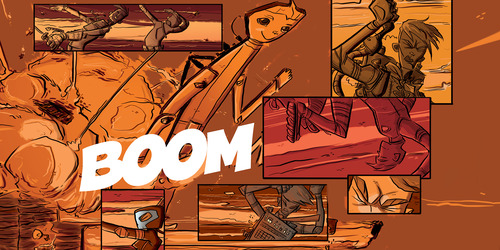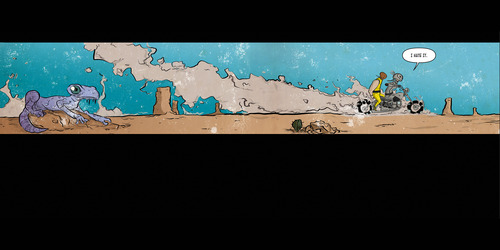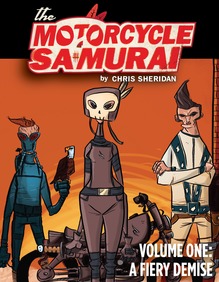Cartoonist Chris Sheridan’s Motorcycle Samurai is the glorious result of mashing together Western shoot-em-ups, jumpsuit-clad wandering swordswomen, Mad Max-ian desert survivalism and a sheriff rocking an Elvis pompadour and deep love of coffee. On shelves in bookstores this week, Motorcycle Samurai Volume One: A Fiery Demise is also the result of years of labor from Sheridan, a relative newcomer to published comics who helped publisher Top Shelf pioneer the digital-first guided-view format.
Hosted online at comiXology and Thrillbent, Motorcycle Samurai takes full advantage of the digital tricks available to Sheridan, including animated transitions and dialogue that fades in and out of panels. For Motorcycle Samurai’s first print collection, Sheridan combed through the book with a designer’s eye, choosing key frames, creating new art, and laying out a version of the story that stands alongside the digital-first iteration as its own distinct product.
![]()
Paste chatted with Sheridan over the phone to discuss the influences he proudly wears on his sleeve, the rigors of creating a book for the web and translating it to print and fan-casting his own characters.
Paste: You’ve explained before that Motorcycle Samurai got its start in an Elvis-themed convention sketchbook. At what point did it become clear to you that you had a complete story brewing around these stray ideas about Bruce Lee, Mad Max and old Westerns?
Chris Sheridan: Just in terms of visual elements, it was really appealing, and that drove me to continue. I felt like there was a depth of environment and character. Storytelling-wise, I’m a big person for action-as-character, and action or character as plot, and there was a lot to mine and a lot to explore. I definitely wasn’t going to get bored. [Laughs]
I remember reading Mignola talk about Hellboy and say he could have made him just a regular guy, but he would have gotten bored drawing him over and over. So that was a good impulse to think, if you end up getting to draw this character for a long time, make it someone interesting. Elvis and the ‘70s and Bruce Lee—they were so rich and so interesting, it helped me really explore a time frame I wasn’t familiar with, and to understand why they were so popular and pull out elements I was really interested in and continue to play with those.

Motorcycle Samurai Art by Chris Sheridan
Paste: How did you decide the Bruce Lee character was going to be a woman in your story?
Sheridan: I actually did go through an iteration where the White Bolt was a dude with spiky white hair. Partly, it was just to differentiate the characters, but narratively, it wasn’t that compelling to have it be a man. Once it switched to being a woman, it opened up a lot of areas to explore, and that just became another level of interest to the story and backstory. Part of what I was interested in was defining [Motorcycle Samurai] not as a traditional Western, and when I realized [making the White Bolt female] was an avenue I could go down, it just opened up that much more.
Paste: Your original pitch actually includes fantasy casting for all of the characters. How useful is that to you, as a creator, as you’re determining character voices and actions?
Sheridan: I think it helps differentiate voice and look and tone. I also thought it was a lot of fun to explore. Part of the pitch was a mash-up Western that had never been done: Clint Eastwood and John Wayne. They were the two biggest Western stars that never overlapped on screen, so just trying to figure out how that Traditional Western would play with the Antihero Western, and in exploring that, it meant going back and watching a lot of those movies. It helped me to find character actors who hadn’t been used in that way, like Toshiro Mifune. Imagine what he could do. I remember watching Grand Prix, where he was basically an administrative character, and the idea of him being a racecar driver was so much more interesting to me. It was sort of a jumping-off point to explore what those characters could be, and imagine those iconic actors in a different environment with no parameters.
Paste: Motorcycle Samurai wears its influences on its sleeve and doesn’t seem to take itself too seriously. There are blowout action scenes, but the heroes treat the confrontations like more of a hassle than a heroic destiny. Was it important for you to inject humor into the book?
Sheridan: Yeah, definitely. I think the tone was important to me, not to have it be too heavy. Those elements of fun are part of what I wanted to make sure were front and center. Again, I think Hellboy is a good framework for not being too heroic or taking itself too seriously. I didn’t want [Motorcycle Samurai] to get too over the top, and I think a blend of humor can help ground the absurdity. You can’t really look at those characters and take them too seriously, that’s a natural part of it. Plus, I feel if you look at any classic Western, there are always humor elements in those movies, whereas modern superhero books tend to get a little heavy. For me, this is supposed to be fun.

Motorcycle Samurai Art by Chris Sheridan
Paste: The major action scenes in the last third of the book stick to a pretty restricted palette, not unlike the swamp scene in Mad Max: Fury Road. What inspired you to pull back on the colors for the climax?
Sheridan: Partly, it was just a natural development of moving into the nighttime scenes, but it also helped focus on the intensity of the action and pare it down. I felt like I was drawing on the early Western look at the beginning of the book, and maybe doing something like the Technicolor 70 mm John Ford kind of blown-out color. Those funny-looking Westerns, even Back to the Future Part III when Marty goes back to the Wild West and is wearing a pink outfit with tassels, things like that—our interpretation of a Western and then moving into a more intense delineation of where we’re going. I guess if I look at it conceptually, that was the inspiration.
Partially, it’s also the fact that the book took over two years. I just got more capable. That’s reflected in the book. It’s an amalgamation. I definitely went back and recolored because it was going from digital [to print] and the overall palette got more constructed through time. That was a craft and editorial decision on my part. Talking to other creators about process, you can totally see within your own work—and maybe even notice in other people’s work—the change over time, but I felt like I should reflect the more refined process [of Motorcycle Samurai’s later portions] across the whole book. A number of panels have been redrawn and recolored.
The difference between digital and print, what work for each, means they are kind of their own creative executions per platform, and it’s not a one-to-one execution. For example, some of the things that were splash pages in the print version were redone from two-screen swipes in the digital versions. Those dimensions are very different. At the time, I was creating the digital book to be the coolest and most engaging execution for the narrative, but when it came time to do the print, I was following that same impulse but on a different platform.

Motorcycle Samurai Art by Chris Sheridan
Paste: Motorcycle Samurai was at the forefront of guided view comics when it first came out, and was Top Shelf’s first entry to that arena. How difficult was it to adapt your storytelling to fit this format? Were you fluent in the tech?
Sheridan: That process was really new to me, but coming from the background of being a graphic designer, it was also really exciting. It seemed to be applying assets to tell the story, which I feel pretty comfortable doing in my day job already. comiXology was open to providing examples of what had been used before, but part of what made it really interesting is that this was the first partnership between Top Shelf and comiXology, so there were not a lot of ground rules. It was whatever I could make work in that platform. We established the parameters of the tech, which was essentially two screens wide or two screens high, and there were elements you could have that were a little bit like animation or panning, but it was really just trying to figure out a new way to tell the story in a unique fashion. A lot of experimentation, a lot of blue line, a lot of storyboards and animatics. I feel like my background in film and animation helped a lot as well because it used familiar terminology for a different process. It felt familiar but in a unique fashion, comfortable.
After the first issue, I went back and reworked what the print execution might be. Because there’s no limit in digital with the page count and I knew going in with Top Shelf that it was going to be a graphic novel, the story could grow organically out of its own narrative and what scenes required. I wasn’t worried how that was going to play out in print until much more recently. It was really about utilizing pacing and timing and the editorial effects or narrative effects you want to use without limits. It was pretty much just me playing around. There were a number of panning effects in the opening chapters, but I moved away from that. I think [guided-view] is something that’s still being defined, in terms of language and how you talk about page counts or screens or effects within the book—or if you even call it a book. [Laughs]
Paste: On the flip side, was it a substantial challenge to adapt the guided-view panels back into a traditional print layout? Certain digital-first comics look quite clunky in print, but this feels seamless, like it was always meant to exist off the screen.
Sheridan: Recreating or creating original [print] content was probably 15 percent of the work for the print version, but that would include some coloring. I kind of looked at it as the animation idea of key frames, and would end up pulling out a key frame in whatever scene had used multiple screens. Part of it was looking at it as a designer, planning to use that space accordingly whether it was in print or digital. It was all built digitally, and the way the print files were laid out allowed the ability to crop or cut. The fact that I was the one doing it made it natural. It wasn’t an editorial decision being made by someone else, it was the same execution of the story, but maybe at a different pace or different scale. Maybe that changed some of the layout with the word balloons or how the dialog unfolded, but it still resulted in the same story. In that way, it’s interesting that they’re unique versions, and one’s not better than the other.

Motorcycle Samurai Art by Chris Sheridan
Paste: For readers coming to Motorcycle Samurai for the first time in print, what’s next for the White Bolt? She’s still pretty mysterious by the time you turn the final page.
Sheridan: There’s a lot of room still to cover, and I definitely look at this as an opening chapter, which is why I didn’t feel the need to rush through explaining or clarifying a lot of what was going on. You really only get one opportunity to introduce someone and not get immediate clarity, and for me, it’s more interesting when you don’t know what they’re doing or why they’re doing it. There’s a lot still to unfold and I just wanted to take time with that execution, play it out over a series of stories over a number of years.
The world itself feels like it has lots of room to grow and explore, and the main narrative is definitely going to keep driving, getting more clarity going forward, but there are also a lot of fun side characters and parts of the world that can be built out as well. If anyone is familiar with the digital series, there are a lot of interludes that deviate from the main narrative that’s collected within the book, so I could see doing more of that side story or parallel. I feel like the digital platform is really great for exploration and it’s where this story originally found its format and I’d love to continue to play in that. There’s still a lot of room to grow in that regard.
Going through the whole process of digital to print, I think there are elements that I could execute in a stronger manner going forward. It’s definitely interesting to see it play out over a longer period, and see it roll out in segments that may not be issue one and issue two, but chapters. That’s the kind of interesting exploration I would want to continue, the way you could narratively break out a novel and release that chapter by chapter. It might be a little stranger than if you released it issue by issue and then collected in a trade. For good and bad, Motorcycle Samurai took a long time, but it also didn’t follow that traditional issue format and it might have played out a little differently if it had.
Paste: Motorcycle Samurai is your first major comic work. What’s next on the horizon?
Sheridan: There are a couple other projects that are coming up that I’m really interested in, but those details are still getting ironed out. I would just say, anybody who’s involved in reading comics today is being slowly introduced to what it’s like to read digitally, and to just continue to use that platform to drive where you might want to go in print. I think it makes a big difference. You’re not limited by print costs within digital, and if you can push any creators you’re interested in in the digital world and help them find a foothold and have a better place to tell their stories, that would be my takeaway.

